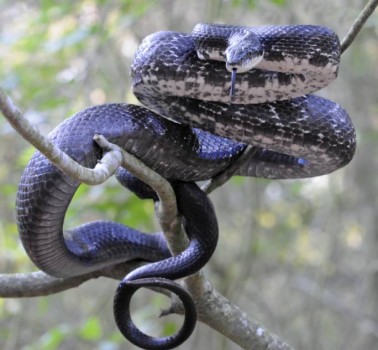
In the kind of sink-or-swim situation that climate change presents for species, we often focus on the losers. Today we look at an unlikely winner.

In the pantheon of winners and losers from climate change, there may be good news for ratsnakes. John White/U.S. Fish & Wildlife Service
Reptiles are ectotherms, meaning they're cold-blooded. The term, by the way, as you probably know, doesn't mean their blood is cold; it means that their body temperature is controlled by external temperatures. (We humans and other endotherms are able to self-regulate our body temps, an ability referred to as warm-blooded.)
In general, ectothermic creatures are believed to be more sensitive to rising temperatures because their body temperatures rise with the ambient temperature. So does this spell doom for all reptiles? No, according to a new study on ratsnakes.
Writing in the Journal of Thermal Biology, Patrick Weatherhead of the University of Illinois and colleagues report on the results of a comparative study of the behavior of ratsnakes in Texas, Illinois, and Ontario, Canada, that led them to conclude that the darling little slitherers will do just fine as a result of warmer temperatures.
The Life of an Ectotherm
One of the key aspects of ratsnakes that led to the authors' conclusions is that they are ectotherms. And so unlike us endotherms (OK, I'm making an assumption about my readership) who regulate our internal temperature, ectotherms allow their temperatures to swing with the environment. The advantage to this strategy is not having to expend energy to self-regulate temperature. The cost is only being able to be active when environmental temperatures fall within an acceptable range.
So how might ratsnakes with their ectothermmic strategy fare in a warmer world? To answer that question, the authors studied the behavior of three cohorts of ratsnakes doing their thing in three different temperature regimes: the relatively warm environment of Texas, a more moderate Illinois and the relatively cold clime of Ontario.
Their conclusion: "a 3 C increase in ambient temperature will generally improve thermal conditions for all three populations." A major reason for this is that the snakes’ predicted response to increased temperatures will simply be to shift their activity to times when temperatures are ideal.
According to the study, the populations in Illinois and Ontario, which tend to tolerate a wider range of temperatures to begin with, will find more periods of time when temperatures are suitable, for example perhaps emerging from hibernation earlier in the spring. Snakes in Texas may experience more times in the summer when temperatures are too hot, but may be able to compensate by becoming more nocturnal.
Now, I began this post talking about one of the winners expected in our warming world. And where there's winners, there's usually losers.
While snakes may end up prevailing in a warmer environment because they are able to change their behavior, other ectotherms like lizards, the study points out, may not fare so well. The authors speculate that, because of the effects of climate change on a given ectotherm's ability to alter its behavior to suit the thermal environment, "the consequences of climate warming may be very different for these two groups of reptiles."
And what about us human endotherms?Well, ratsnakes may do pretty well by becoming nocturnal; maybe we'll just have to make like a night owl. How, you ask? I suggest you start here.
Crossposted with TheGreenGrok | Follow us on Facebook